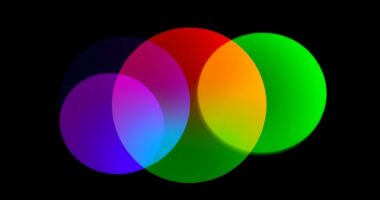Your brain decodes color through opponent-process theory, which uses opposing signals to interpret what you see. Your eyes have specialized cells called cones that detect different wavelengths of light, sending signals that the brain organizes into pairs like red-green and blue-yellow. When one channel activates, the other is suppressed, creating a seamless color experience. This dynamic system explains phenomena like afterimages. To discover more about how this process works, keep exploring the fascinating details behind your visual perception.
Key Takeaways
- The brain interprets color through opponent channels like red-green and blue-yellow, which work against each other to produce perceived hues.
- When one color channel is activated, its opposing channel is suppressed, creating a balanced perception of color.
- Afterimages occur when overstimulation causes an opponent channel to remain active, leading to complementary color illusions.
- Opponent-process theory simplifies complex visual signals, enabling rapid and accurate color recognition.
- This neural mechanism enhances visual perception by dynamically regulating color signals and reducing processing complexity.

The Opponent-Process Theory explains how our emotional reactions are regulated through paired processes that work in opposition. But this theory isn’t limited to emotions; it also provides a compelling explanation for how we perceive color. When you look at the world around you, your visual processing system interprets signals from your eyes, translating light into the vibrant colors you see every day. This process involves specialized cells in your retina called cones, which are sensitive to different wavelengths of light. However, the way your brain interprets these signals isn’t straightforward—it’s governed by the principles of opponent processing.
In essence, your brain organizes color perception into pairs of opposing signals. Think of these pairs as color channels that work against each other. For example, red and green form one pair, while blue and yellow form another. When your visual system detects a strong signal for red, it suppresses the green channel, making the color appear distinctly red. Conversely, if the green channel is more active, the color appears green. This push-and-pull dynamic helps your brain efficiently distinguish between different hues and creates the vivid spectrum of colors you see. The opponent-process mechanism simplifies the complex task of visual processing by reducing the number of signals your brain needs to interpret, allowing for swift and accurate color recognition.
Your visual processing system continually evaluates the balance between these opposing signals. When you stare at a brightly colored object, the corresponding opponent channel is strongly activated, and the other is suppressed. When you shift your gaze, the balance shifts as well, giving you a seamless experience of color progression. This process explains phenomena like afterimages—when, after staring at a red object, you might see a greenish afterimage once you look away. Your visual system was momentarily over-activated by the red channel, so when it stops, the opposing green channel becomes more prominent, creating that afterimage. Additionally, understanding the specialized cells involved in this process reveals how your brain efficiently decodes visual information.
Staring at colors activates opponent channels, causing afterimages when the balance shifts.
Understanding the opponent-process theory sheds light on how your brain simplifies complex visual information into manageable signals, enabling rich color perception. It highlights the elegant interplay between various neural pathways that decode the spectrum of light into the colors you experience. Your visual processing isn’t just passive reception; it’s an active, dynamic system designed for clarity and efficiency. Recognizing this process enhances your appreciation for the intricate mechanisms behind everyday sights, demonstrating how your brain’s paired, opposing signals decode the vibrant world around you.
Frequently Asked Questions
How Does Opponent-Process Theory Relate to Color Blindness?
Color blindness affects how you perceive colors, often caused by issues in neural pathways responsible for color perception. Opponent-process theory explains this because it shows how your brain processes colors through opposing channels, like red-green or blue-yellow. When these pathways malfunction, your ability to distinguish certain colors diminishes. So, understanding this theory helps clarify why some people see the world with limited or altered color perception.
Can Opponent-Process Theory Explain Afterimages?
Imagine your eyes as a camera, constantly adjusting to light changes. Yes, opponent-process theory explains afterimages through visual adaptation, where your brain’s color perception shifts after staring at a vivid image. When you look away, the overstimulated cells rebound, creating a ghostly afterimage. This process highlights how your visual system balances color signals, maintaining harmony even after exposure to intense hues.
How Does the Brain Determine the Hue of a Color?
You determine the hue of a color through your brain’s color processing system, which interprets signals from your eyes. When light enters your eyes, specialized cells send information to your brain, where it analyzes the wavelength to perceive hue. This process allows you to distinguish vibrant reds from calming blues, giving you a vivid experience of color. Your brain’s interpretation of these signals is essential for accurate hue perception.
Are There Individual Differences in Opponent-Process Responses?
You might notice perceptual variability and genetic influences shaping your color experiences. Individual differences in opponent-process responses exist, influenced by genetics, age, and even environmental factors. These variations affect how your brain interprets signals from your eyes, leading to subtle differences in hue perception. So, your unique genetic makeup and life experiences create a personalized color decoding process, making your perception distinct from others’.
How Does Opponent-Process Theory Integrate With Other Color Vision Models?
You see, understanding how your brain processes color involves integrating opponent-process theory with other models like the trichromatic theory. It shows how neural pathways in your retina and brain work together, decoding signals for colors like red-green and blue-yellow. These models complement each other, revealing that your color processing isn’t just one pathway but a complex network, ensuring your vision is rich and accurate.
Conclusion
Think of your brain as a skilled artist working with a vibrant palette. It constantly blends and balances colors, creating harmony from contrasting hues. The opponent-process theory is like this artist’s secret recipe, helping you see the world in vivid reds versus greens or blues versus yellows. By understanding this, you realize your mind’s own color symphony is always playing, turning everyday sights into a beautifully coordinated masterpiece. Your brain truly is a masterful artist behind the scenes.









